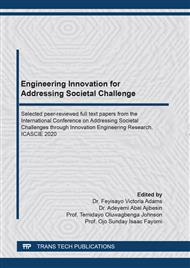p.85
p.97
p.113
p.122
p.129
p.137
p.144
p.151
p.159
Prospects of Calcined Clay Pozzolan and Hydraulic Lime in Built Industry
Abstract:
The harmful impact of Portland cement manufacture on a global scale has prompted an extensive search for clinker replacement materials and alternative low CO2 cements. This paper investigated prospects and application of Calcined Clay Pozzolan with Hydraulic Lime in built industry. Limestone and Raw clay from Ewekoro and Owode-Ketu areas in Ogun State were sourced for the production after being calcined in kiln at temperatures of 950°C and 700°C for 2 hours respectively. Binders were produced by blending Calcined lime (L) and Calcined clay (C) together by mass in different variations (20%L:80%C; 40%L:60%C; 60%L:40%C; 80%L:20%C; 100%L:0%C). Consequently, these binders were mixed with fine aggregate to produce mortar cubes at a mix ratio and water cement ratio of 1:3 and 0.5 respectively. An average of 3 cubes were cast per mix to produce a total of 90, 100mm cubes and cured by water sprinkling for 3, 7, 14, 21, 28 and 90 days respectively. These cubes were subjected to bulk density and compressive strength tests in order to ascertain their durability. Owode-Ketu calcined clay was found to be a class N Pozzolana according to ASTM C618-08. The densities and compressive strengths of the various cubes ranged between 1785 – 1870 kg/m3 and 0.15 – 1.09 MPa respectively for all the curing periods. The binder 60%L:40%C was found to be the best of all the binders owing to its compressive strength (0.89 MPa) after 28 days curing period. All binders except 100%L:0%C could be used in any masonry, rendering, plastering and pointing application because they exhibited compressive strengths in the range of 0.4 to 2.5 MPa after 28 days curing period.
Info:
Periodical:
Pages:
129-136
Citation:
Online since:
June 2021
Keywords:
Price:
Сopyright:
© 2021 Trans Tech Publications Ltd. All Rights Reserved
Share:
Citation:


